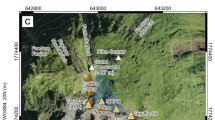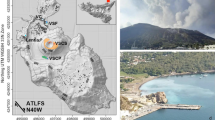Abstract
At Vesuvio, a significant fraction of the rising hydrothermal−volcanic fluids is subjected to a condensation and separation process producing a CO2−rich gas phase, mainly expulsed through soil diffuse degassing from well defined areas called diffuse degassing structures (DDS), and a liquid phase that flows towards the outer part of the volcanic cone. A large amount of thermal energy is associated with the steam condensation process and subsequent cooling of the liquid phase. The total amount of volcanic−hydrothermal CO2 discharged through diffuse degassing has been computed through a sequential Gaussian simulation (sGs) approach based on several hundred accumulation chamber measurements and, at the time of the survey, amounted to 151 t d−1. The steam associated with the CO2 output, computed assuming that the original H2O/CO2 ratio of hydrothermal fluids is preserved in fumarolic effluents, is 553 t d−1, and the energy produced by the steam condensation and cooling of the liquid phase is 1.47×1012 J d−1 (17 MW). The location of the CO2 and temperature anomalies show that most of the gas is discharged from the inner part of the crater and suggests that crater morphology and local stratigraphy exert strong control on CO2 degassing and subsurface steam condensation. The amounts of gas and energy released by Vesuvio are comparable to those released by other volcanic degassing areas of the world and their estimates, through periodic surveys of soil CO2 flux, can constitute a useful tool to monitor volcanic activity.








Similar content being viewed by others
References
Allard P, Carbonelle J, Dajalevic D, Le Bronec J, Morel P, Robe MC, Maurenas JM, Faivre−Pierrette R, Martin D, Sabroux JC, Zettwoog P (1991) Eruptive and diffusive emissions of CO2 from Mt. Etna. Nature 351:387–391
Allard P, Jean−Baptiste P, D’Alessandro W, Parello F, Parisi B, Flehoc C (1997) Mantle−derived helium and carbon in groundwaters and gases of Mount Etna, Italy. Earth Planet Sci Lett 148:501–516
Arnò V, Principe C, Rosi M, Santacroce R, Sbrana A, Sheridan MF (1987) Eruptive history. In: Santacroce R (ed) Somma−Vesuvius. CNR Quaderni de La Ricerca Scientifica, Roma 114–8, pp 53–103
Barberi F, Bizouard H, Clocchiatti R, Metrich N, Santacroce R, Sbrana A (1981) The Somma−Vesuvius magma chamber: a petrological and volcanological approach. Bull Volcanol 44:295–315
Barberi F, Leoni L (1980) Metamorphic carbonate ejecta from Vesuvius Plinian eruptions: evidence of the occurrence of shallow magma chambers. Bull Volcanol 43:107–120
Baubron JC, Allard P, Toutain JP (1990) Diffuse volcanic emissions of carbon dioxide from Vulcano Island, Italy. Nature 344:51–53
Brocchini D, Laurenzi MA, Principe C (1996) Nuove datazioni delle lave del pozzo Trecase 1 (Campania). In: Atti del XII Convegno Annuale GNV−CNR, Napoli, pp 110–111
Brombach T, Hunziker JC, Chiodini G, Cardellini C, Marini L (2001) Soil diffuse degassing and thermal energy fluxes from the southern Lakki plain, Nisyros (Greece). Geophys Res Lett 28:69–72
Brown G, Rymer H, Dowden J, Kapadia P, Stevenson D, Baquero J, Morales LD (1989) Energy budget analysis for Poàs crater lake: implications for predicting volcanic activity. Nature 339:370–373
Caliro S, Chiodini G, Avino R, Cardellini C, Frondini F (2004) Volcanic degassing at Somma−Vesuvio (Italy) inferred by chemical and isotopic signatures of groundwater. Appl Geochem (submitted)
Caliro S, Panichi C, Stanzione D (1998) Baseline study of the isotopic and chemical composition of waters associated with the Somma−Vesuvio volcanic system. Acta Vulcanol 10:19–25
Cardellini C, Chiodini G, Frondini F (2003) Application of stochastic simulation to CO2 flux from soil: mapping and quantification of gas release. J Geophys Res 108:2425, DOI 10.1029/2002JB002165
Chiodini G, Allard P, Caliro S, Parello F (2000a) 18O exchange between steam and carbon dioxide in volcanic and hydrothermal gases: isotopic and genetic implications. Geochim Cosmochim Acta 64:2479–2448
Chiodini G, Avino R, Brombach T, Caliro S, Cardellini C, De Vita S, Frondini F, Marotta E, Ventura G (2004) Fumarolic degassing west of Mount Epomeo, Ischia (Italy). J Volcanol Geotherm Res 133:291–309 DOI:10.1016/s.svolgeores.2003.02.001
Chiodini G, Cioni R, Guidi M, Marini L, Raco B (1998) Soil CO2 flux measurements in volcanic and geothermal areas. Appl Geochem 13:543–552
Chiodini G, Frondini F (2001) Carbon dioxide degassing from the Albani Hills volcanic region, Central Italy. Chem Geol 177:67–83
Chiodini G, Frondini F, Cardellini C, Granieri D, Marini L, Ventura G (2001a) CO2 degassing and energy release at Solfatara volcano, Campi Flegrei, Italy. J Geophys Res 106:16213–16221
Chiodini G, Frondini F, Cardellini C, Parello F, Peruzzi L (2000b) Rate of diffuse carbon dioxide degassing estimated from carbon balance of regional aquifers: The case of central Apennine, Italy. J Geophys Res 105:8423–8434
Chiodini G, Frondini F, Raco B (1996) Diffuse emission of CO2 from the Fossa crater, Vulcano Island (Italy). Bull Volcanol 58:41–50
Chiodini G, Marini L (1998) Hydrothermal gas equilibria: The H2O−H2−CO2−CO−CH4 system. Geochim Cosmochim Acta 62:2673–2687
Chiodini G, Marini L, Russo M (2001b) Geochemical evidence for the existence of high−temperature hydrothermal brines at Vesuvio volcano, Italy. Geochim Cosmochim Acta 65:2129–2147
Cioni R, Santacroce R, Sbrana A (1999) Pyroclastic deposit as a guide for reconstructing the multi−stage evolution of the Somma−Vesuvius caldera. Bull Vulcanol 60:207–222
David M (1997) Geostatistical ore reserve estimation. Elsevier, Amsterdam, pp 1–364
Deines P, Gold DP (1973) The isotopic composition of carbonatite and kimberlite carbonates and their bearing on the isotopic composition of deep−seated carbon. Geochim Cosmochim Acta 37:1709–1733
Deutsch CV, Journel AG (1998) GSLIB: Geostatistical software library and users guide. Oxford University Press, New York, pp 1–369
Federico C, Aiuppa A, Allard P, Bellomo S, Jean−Baptiste P, Parello F, Valenza M (2002) Magma−derived gas influx and water−rock interactions in the volcanic aquifer of Mt. Vesuvius, Italy. Geochim Cosmochim Acta 66:963–981
Giggenbach WF (1992) Isotopic shifts in waters from geothermal and volcanic systems along convergent plate boundaries and their origin. Earth Planet Sci Lett 113:495–510
Hernández PA, Notsu K, Salazar JM, Mori T, Natale G, Okada H, Virgili G, Shimoike Y, Sato M, Pérez NM (2001) Carbon dioxide degassing by advective flow from Usu volcano, Japan. Science 292:83–86
Hernández PA, Notsu K, Tsurumi M, Mori T, Ohno M, Shimoike Y, Salazar JML, Pérez NM (2003) Carbon dioxide emissions from soils at Hakkoda, north Japan. J Geophys Res 108:2210, DOI 10.1029/2002JB001847
Hernández PA, Pérez NM, Salazar JML, Nakai S, Notsu K, Wakita H (1998) Diffuse emission of carbon dioxide, methane and helium−3 from Teide volcano, Tenerife, Canary Islands. Geophys Res Lett 25:3311–3314
Hurst AW, Bibby HM, Scott BJ, McGuinness MJ (1991) The heat source of Ruapehu Crater Lake; deductions from the energy and mass balances. J Volcanol Geotherm Res 46:1–20
Ippolito F, Ortolani F, Russo M (1973) Struttura marginale tirrenica dell’Appennino Campano: Reinterpretazione dei dati di antiche ricerche di idrocarburi. Mem Soc Geol Ital 12:227–250
Joron JL, Metrich N, Rosi M, Santacroce R, Sbrana A (1987) Chemistry and petrography. In: Santacroce R (ed) Somma−Vesuvius. CNR Quaderni de La Ricerca Scientifica, Roma 114–8, pp 105–174
Keenan JH, Keyes FG, Hill PG, Moore JG (1969) Steam tables. Thermodynamic properties of water including vapor, liquid, and solid phases (International ed., metric units). Wiley, New York, pp 1–162
Keith ML, Weber JN (1964) Isotopic composition and environmental classification of selected limestones and fossils. Geochim Cosmochim Acta 28:1787–1816
Kyser TK (1986) Stable isotope variations in the mantle. In: Valley JW, Taylor HP Jr, O’Neil JR (eds) Stable isotopes in high−temperature geological processes. Rev Mineral 16:141–164
Ohmoto H, Goldhaber MB (1997) Sulfur and carbon isotopes. In: Barnes HL (ed) Geochemistry of hydrothermal ore deposits, 3d edn. Wiley, New York, pp 517–612
Pasternack GB, Varekamp JC (1997) Volcanic lake systematics I. Physical constraints. Bull Volcanol 58:528–538
Pescatore TS, Sgrosso I (1973) I rapporti tra la piattaforma campano−lucana e la piattaforma abruzzese−campana nel casertano. Boll Soc Geol Ital 92:925–938
Principe C, Bocchini D, Perillo M (1999) The “Cognoli di Trocchia” volcano and Monte Somma growth. Plinius 22:316–317
Principe C, Rosi M, Santacroce R, Sbrana A (1987) Explanatory notes to the geological map. In: Santacroce R (ed) Somma−Vesuvius. CNR Quaderni de La Ricerca Scientifica, Roma 114–8, pp 11–51
Richet P, Bottinga Y, Javoy M (1977) A review of H, C, N, O, S and Cl stable isotope fractionation among gaseous molecules. Ann Rev Earth Planet Sci 5:65–110
Rogie JD, Kerrick DM, Sorey ML, Chiodini G, Galloway DL (2001) Dynamics of carbon dioxide emission at Mammoth Mountain, California. Earth Planet Sci Lett 188:535–541
Rosi M, Principe C, Vecci R (1993) The 1631 eruption of Vesuvius reconstructed from the review of chronicles and study of deposits. J Volcanol Geotherm Res 58:151–182
Salazar JML, Hernández PA, Pérez NM, Melián G, Alvarez J, Notsu K (2001) Diffuse emission of carbon dioxide from Cerro Negro volcano, Nicaragua, Central America. Geophys Res Lett 28:4275–4278
Santacroce R (1983) A general model for the behaviour of the Somma−Vesuvius volcanic complex. J Volcanol Geotherm Res 17:237–248
Shepherd JB, Sigurdson H (1978) The Soufriere Crater Lake as a calorimeter. Nature 271:344–345
Sinclair AJ (1974) Selection of threshold values in geochemical data using probability graphs. J Geochem Explor 3:129 –149
Sorey ML, Evans WC, Kennedy BM, Farrar CD, Hainsworth LJ, Hausback B (1998) Carbon dioxide and helium emissions from a reservoir of magmatic gas beneath Mammoth Mountain, California. J Geophys Res 103:15303:15323
Tedesco D (1997) Systematic variations in the 3He/4He ratio and carbon of fumarolic fluids from active volcanic areas in Italy: evidence for radiogenic 4He and crustal carbon addition by the subducting African plate? Earth Planet Sci Lett 151:255–269
Tedesco D, Scarsi P (1999) Reply to ‘Helium isotopes in historical lavas from Mount Vesuvius’, a comment on ‘Noble gas isotopic ratios from historical lavas and fumaroles at Mount Vesuvius’ by D. Tedesco et al. Earth Planet Sci Lett 174:245–246
Thompson G (1798) Sur la nature des marbres vomis par le Vesuve et sur l’etendue possible des influences volcaniques. Bibl Br Lat 7:40–85
Valley JW (1986) Stable isotope geochemistry of metamorphic rocks. In: Valley JW, Taylor HP Jr, O’Neil JR (eds) Stable isotopes in high−temperature geological processes. Rev Mineral 16:445–489
Ventura G, Vilardo G, Bruno PP (1999) The role of flank collapse in modifying the shallow plumbing system of volcanoes: an example from Somma−Vesuvius, Italy. Geophys Res Lett 26:3681–3684
Acknowledgements
We thank Hiroshi Shinohara, Nemesio Pérez and Kenneth McGee for their helpful reviews and comments. This work was financially supported by GNV-INGV (Italian National Group for Volcanology) and by MIUR (GEOCO2 Project).
Author information
Authors and Affiliations
Corresponding author
Additional information
Editorial responsibility: H. Shinohara
Rights and permissions
About this article
Cite this article
Frondini, F., Chiodini, G., Caliro, S. et al. Diffuse CO2 degassing at Vesuvio, Italy. Bull Volcanol 66, 642–651 (2004). https://doi.org/10.1007/s00445-004-0346-x
Received:
Accepted:
Published:
Issue Date:
DOI: https://doi.org/10.1007/s00445-004-0346-x




